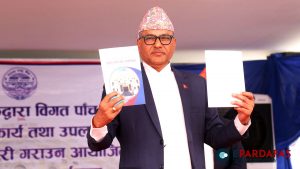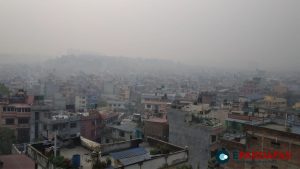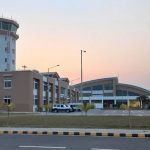
Once viable Lalikharka wears deserted look without tourists

Lalikharka in Taplejung district lies on the way to the Mount Kanchenjunga, the third highest mountain in the world.
Around seven kilometres away from the Suketar Airport, and at an altitude of 2,200 metres above sea level, lies Lalikharka, a mountain village on the way to the Kanchenjunga South Base Camp. Lalikharka was once viable and popular transit to the base camp. It takes around three-hour walk to reach the village from the airport. Tourists on the Kanchenjunga base camp trek went through the village, and it was until development activities have had their impact just some years ago.
The motorable road leading to the base camp through the village has somehow become a ‘nuisance’ to the tourism entrepreneurs who have built infrastructures for tourists at the cost of thousands of rupees. The motorable road means tourists and trekkers going to the base camp now rarely use the route through the village. As a result, the village wears a deserted look with infrastructures and hotels desperately looking for tourists and visitors, who now hardly make it to the village, said the local hotel entrepreneurs.
One of them is Dhan Bahadur Bista. Bista constructed lodge for tourists in 2040 BS reportedly becoming the first person to construct a house in the village. Lalikharka would be flooded with tourists heading to Mt Kanchenjunga. The incomes were also good. Bista’s incomes from tourism were good enough to support his family and provide education to his children. He was followed by many other tourism entrepreneurs who constructed many infrastructures and opened hotels for tourists heading to the mountain.
Shukraj Limbu was also allured by the dense mobility of tourists at Lalikharka. He opened a hotel. He also dealt with the large flow of tourists by setting up a tent in the open. The local agricultural products also got the good market. However, all these activities were short-lived due to the motorable road leading to the mountain through the village. Now, all these infrastructures have become like useless without the flow of tourists, said the local people.
In the past, airway is the only way to reach Suketar from Kathmandu, the federal capital of Nepal. However, now Phungling is accessible by road. Lalikharka serves as the first station for tourists who reach Phungling by road and air. The motorable road reaches up to Yamphudin of Sirijunga Rural Municipality-7 in the Kanchenjunga area through Lalikharka. With the expansion of road, tourists take a vehicle to the mountain from Phungling through Lalikharka.
There is no other option than seeing the tourists heading to Mt Kanchenjunga on vehicles through Lalikharka, said the local entrepreneurs. Having faced difficulties in sustaining livelihood, the local tourism entrepreneurs have started migrating to elsewhere. Now, the number of hotels and shops has reduced to a few from over a dozen. “It is not worth operating a shop here because there are not customers. Domestic and foreign tourists ply on vehicles through this way,” said a local trader Shukraj Limbu.
Only three families are now living in the entire village. But two of them are making a plan to migrate, said Dhan Bahadur Bista. “They have sold off cows and buffalos. There are not even people to purchase houses here,” he said. With the construction of the motorable road, foot trails in the area have been destructed. “My father and grandfather had pursued hotel business. Our family is dependent on this for livelihood. But now, the situation has it that we have to seek another alternative,” said a local hotel entrepreneur Raj Kumar Bista. But now, he is left high and dry as his hotel is not running smoothly without tourists. “Now, I am worried about how to sustain livelihood,” he said.
Until five years ago, around 700 tourists visited the area annually, according to the Kanchenjunga Conservation Area. Most of the visited tourists would return through both trails of Kanchenjunga. In this way, tourists taking the Lalikharka route would return from the Tamor river, and those taking the Tamor river route would reach Lalikharka.
Most of the people have now left Lalikharka. Raj Kumar is the only person living here. Excessive chill, low agricultural produce, and a lack of income sources and basic facilities are to blame for the human migration from the area.
The influx of tourists has dropped after the road connectivity has been expanded to the every nook and cranny of the area, said the local entrepreneurs. The road connectivity has been expanded up to Yamphudin in the Kanchenjunga south base camp side, and up to Sekathum in the north base camp side.
Not only Lalikharka, Sundar Basti and Kandebhanjyang at Sirijunga-3 and 4, are also without human settlements. There are five hotels operating in the villages. But they are finding it hard to sustain for want of tourists, said a local hotel entrepreneur Subas Basnet. “The influx of tourists was much good in the past. We were providing quality service to visiting tourists. But sights of foreign tourists are rare nowadays,” he said.
Hotel entrepreneurs Gopi Bhattarai and Bishal Mabo have also lost their hope in generating incomes from hotels in the area. Now, tourists take another way to reach Yamphyni. “Tourists embarking on trekking will be short when the road condition becomes good forcing us to seek another alternative,” said Mabo of Mamangkhe. The four-day travel by foot from Suketar to Yamphudin has now shortened to two days through Ganeshchowk of Panchthar, Sinam and Aambegudin. Similarly, it requires a day for tourists to reach Lelep Sekathum from Phungling on a vehicle, the distance where one has to walk three days to cover.












Comments